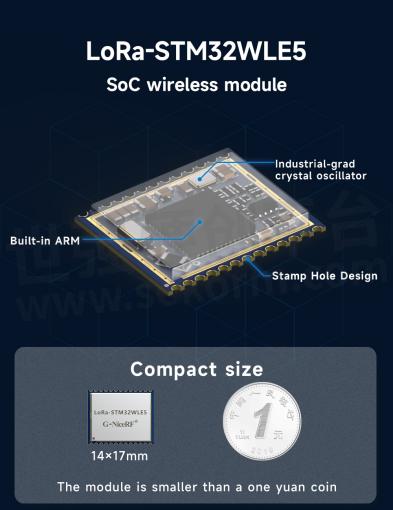The Several Noteworthy Features of LoRa-STM32WLE5 SOC Module

The several noteworthy features of LoRa-STM32WLE5 SOC module
SoC is short for System on Chip, an integrated chip that integrates all or most components of a computer or other electronic system. These components typically include a central processing unit (CPU), memory, input/output interfaces, and auxiliary storage interfaces. Depending on the application, it integrates digital, analog, mixed-signal, and typically RF signal processing functionalities. The main difference between System-on-Chip (SoC) modules and LoRa modules lies in their functionalities and application scopes. SoC modules are highly integrated chips capable of executing complex computing and processing tasks, suitable for a wide range of embedded and consumer electronics applications. LoRa modules are specialized in low-power, long-distance wireless communication, primarily used in IoT applications such as remote monitoring and sensor networks. In summary, SoC module serves as a versatile computing platform, whereas a LoRa module focuses on wireless communication functionalities.
System-on-chip SOC applications
Since the SOC module
is integrated on a single substrate, SoC modules consume significantly
less power compared to equivalent multi-chip designs and occupy much
smaller area. They can perform various functions, including signal
processing, wireless communication, and artificial intelligence. SoCs
are commonly used in embedded systems and IoT. with
the rise of smart homes and connected devices, SoC technology has
become essential in enabling these devices to communicate seamlessly.
SoC technology enables these devices to process data quickly and
accurately, making them more responsive and reliable.
Compared to SoC modules, LoRa communication modules require separate configuration of DPS or MCU for digital signal processing and storage, which increases their volume compared to SoC modules. However, LoRa modules benefit from unique LoRa modulation, offering advantages such as low power consumption and long-range transmission capabilities. These features make LoRa modules well-suited for sensor networks and remote data transmission applications.
Can SoC module also adopt LoRa modulation?
NiceRF's Newly Launched LoRa-STM32WLE5 module, which utilizes the STM32WLE5 chip from STMicroelectronics and
integrates LoRa, (G)FSK, (G)MSK and BPSK modulation. The SOC module is
equipped with a high-performance Arm Cortex-M4 32-bit RISC core, with an
operating frequency of up to 48 MHz, and supports 256KB flash memory
and 64KB RAM. At the same time, the module has a built-in
industrial-grade crystal oscillator, which enables it to maintain a
stable operating state in various working environments.
The earlier discussion mentioned that for LoRa communication modules to handle digital signal processing and data storage, a separate DSP or MCU is required, which increases module size. However, in the SOC module like the LoRa-STM32WLE5, the Arm Cortex-M4 32-bit core integrates a complete set of DSP instructions and an independent Memory Protection Unit (MPU). This integration enhances application security and significantly reduces module size.

The Features of STM32WLE Chip
The STM32WL5 micro-controller
is based on Arm® Cortex®-M4 and Cortex®-M0+ cores running at a
frequency of 48 MHz, along with Semtech's SX126x sub-GHz wireless
technology. It supports an open platform with LoRa®, (G)FSK, (G)MSK, and
BPSK modulations.
The STM32WL5 series adopts development technologies similar to the ultra-low-power STM32L4 micro-controllers, offering comparable digital and analog peripherals. It is suitable for the wide range of simple or complex applications that require extended battery life and longer RF range using sub-GHz transceivers.
The STM32WL5 microcontroller complies with the physical layer requirements of the LoRaWAN® specification, which is published by the LoRa Alliance®.

The STM32WL5 series incorporates multiple communication features, including up to 43 GPIOs, integrated SMPS for optimized power consumption, and various low-power modes to maximize battery life. Dual power outputs and a wide linear frequency range ensure compatibility worldwide.
Overview of STM32WL5 Chip Features
Operating Environment: -40℃ ~105℃
Frequency range150 -960 MHz
256KB Flash Memory, 64KB SRAM
True Random Number Generator (RNG), Hardware Encryption AES 256-bit
Sector Protection against Read/Write Operations (PCROP), Hardware Public Key Accelerator (KPA)
Efficient Embedded SMPS Buck Converter
SMPS to LDO Smart Switch
Low-Power BOR Power-On Reset
Ultra-Low-Power POR/PDR
Programmable Voltage Detector
- +1 Like
- Add to Favorites
Recommend
- G-NiceRF’s New LoRa Spread Spectrum Modulation SOC Wireless Module LoRa-STM32WLE5 with Built-in ARM and Industrial Grade Crystal Oscillator
- G-NiceRF LoRa Backscatter Device LoRa1276-C1 Provides Long-Range Communication with Low-Power
- G-NiceRF LoRa1121 Module Newly Released: Enables Multi-Band Compatibility and Satellite Communication Functionality
- A Brief Discussion on the Data Security Defense Mechanism of the LoRa-STM32WLE5 System-on-Chip (SoC)
- LoRa-STM32WLE5 Module with Open Area Transmission Distance Exceeds 5000 Meters, Sleep Current Less Than 2µA
- LoRa-STM32WLE5 SoC Wireless Module: Achieving Ultra-Long Range and Low-Power High-Performance Wireless Communication
- G-NiceRF‘s FCC Certified Products for Wireless Transceiver Module: LoRa1276-915, RF2401PRO, RF2401F20, RF4463PRO
- What Features Should a Portable Walkie-Talkie Module Have? Take G-NiceRF SA828 for An Example
This document is provided by Sekorm Platform for VIP exclusive service. The copyright is owned by Sekorm. Without authorization, any medias, websites or individual are not allowed to reprint. When authorizing the reprint, the link of www.sekorm.com must be indicated.






























































































































































































































































































































































































































































































































































































































































































































































































































































































